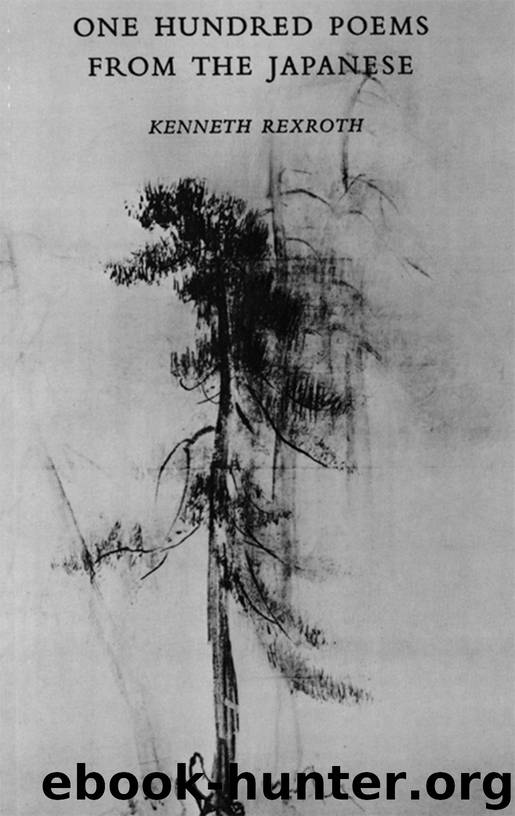100 Poems from the Japanese by Kenneth Rexroth

Author:Kenneth Rexroth [Rexroth, Kenneth]
Language: eng
Format: epub
ISBN: 9780811201810
Publisher: New Directions
Published: 2013-01-23T05:00:00+00:00
Wild goose, wild goose.
At what age
Did you make your first journey?
ISSA
In my life
As in the twilight,
A bell sounds.
I enjoy the freshness of evening.
ISSA
Over the vast field of mustard flowers
The moon rises in the East,
The Sun sets in the West.
BUSON
No one spoke.
The host, the guest.
The white chrysanthemums.
RYŌTA
NOTES
YAMABE NO AKAHITO lived during the reign of the Emperor Shomu, 734-748 A. D. He is thought to have died in 736. He seems to have been in close personal attendance on the Emperor and to have accompanied him on his progresses through the country. His short poems are considered nearly the equal of Hitomaro’s, but the latter’s naga uta, “long poems,” are superior. He is a kasei, a deified poet. The point of the first poem is the contrast of white on white, and as such, is typical of the kind of perception prized in Japanese poetry. The next poem is often used, especially in the dodoitsu form to mean “I had such a good time in the Yoshiwara, or elsewhere in feminine company, I forgot to come home.” It would have had this meaning a thousand years later. In Akahito’s time it probably referred to one of the ladies of the palace, or, of course, it could even mean just what it says. Again, the third poem could refer to the sudden realization of old age during a love affair with a young girl. Asuka was a former Imperial Palace site; this poem is a hanka, a sort of coda to a naga uta, as are several others by Akahito, Yakamochi, and Hitomaro.
AKAZOME EMON lived in the eleventh century, a contemporary of Murasaki, Sei Shonagon, Izumi Shikibu, and Ise Tayii (the Priestess of Ise) — the most brilliant gathering of women in the world’s literature. She was the daughter of the poet Taira no Kanemori and the wife of Oe no Masahira, and a Lady-in-Waiting to the Empress. Akazome Emon is not a true name in the same sense as a man’s name in the classical period. Japanese women did not have proper names but were known by titles, nicknames and sometimes derivatives of a husband or father’s name.
ANONYMOUS. The first poem could mean: “The salvation of Buddha (or Amida) has enraptured both the householder and the monk or nun, but the prostitute worships in her own way, all through the night.” The bird called nightingale by all translators is Homochlamys cantans— the uguisu, a bushwarbler, not related to the European nightingale. The cuckoo is cuculus poliocephalus, the hototogisu, a relative of the European and North American cuckoos. The hototogisu usually sings in the twilight. Its cry, as well as the uguisu’s, is often interpreted by the Japanese as Hokkekyo, the name of the Lotus Sutra. It is also supposed to be a spirit from Hell, and, again, symbolizes the pleasures of the flesh, courtesans and prostitutes, sacred and profane. The second poem could be interpreted similarly, “The promise of Amida’s bliss is so powerful (or the Bodhisattva’s vow is so effective) that the ocean of Karma grows still.
Download
This site does not store any files on its server. We only index and link to content provided by other sites. Please contact the content providers to delete copyright contents if any and email us, we'll remove relevant links or contents immediately.
| Death, Grief & Loss | Epic |
| Family | Inspirational & Religious |
| Japanese & Haiku | LGBT |
| Love Poems | Nature |
| Places |
The Universe of Us by Lang Leav(14985)
The Sun and Her Flowers by Rupi Kaur(14429)
Adultolescence by Gabbie Hanna(8835)
Whiskey Words & a Shovel II by r.h. Sin(7942)
Love Her Wild by Atticus(7686)
Smoke & Mirrors by Michael Faudet(6114)
Wiseguy by Nicholas Pileggi(5645)
The Princess Saves Herself in This One by Amanda Lovelace(4899)
Love & Misadventure by Lang Leav(4783)
Memories by Lang Leav(4730)
Milk and Honey by Rupi Kaur(4684)
Bluets by Maggie Nelson(4458)
Too Much and Not the Mood by Durga Chew-Bose(4254)
Pillow Thoughts by Courtney Peppernell(4188)
Good morning to Goodnight by Eleni Kaur(4177)
The Poetry of Pablo Neruda by Pablo Neruda(4017)
Algedonic by r.h. Sin(3997)
HER II by Pierre Alex Jeanty(3554)
Stuff I've Been Feeling Lately by Alicia Cook(3395)
